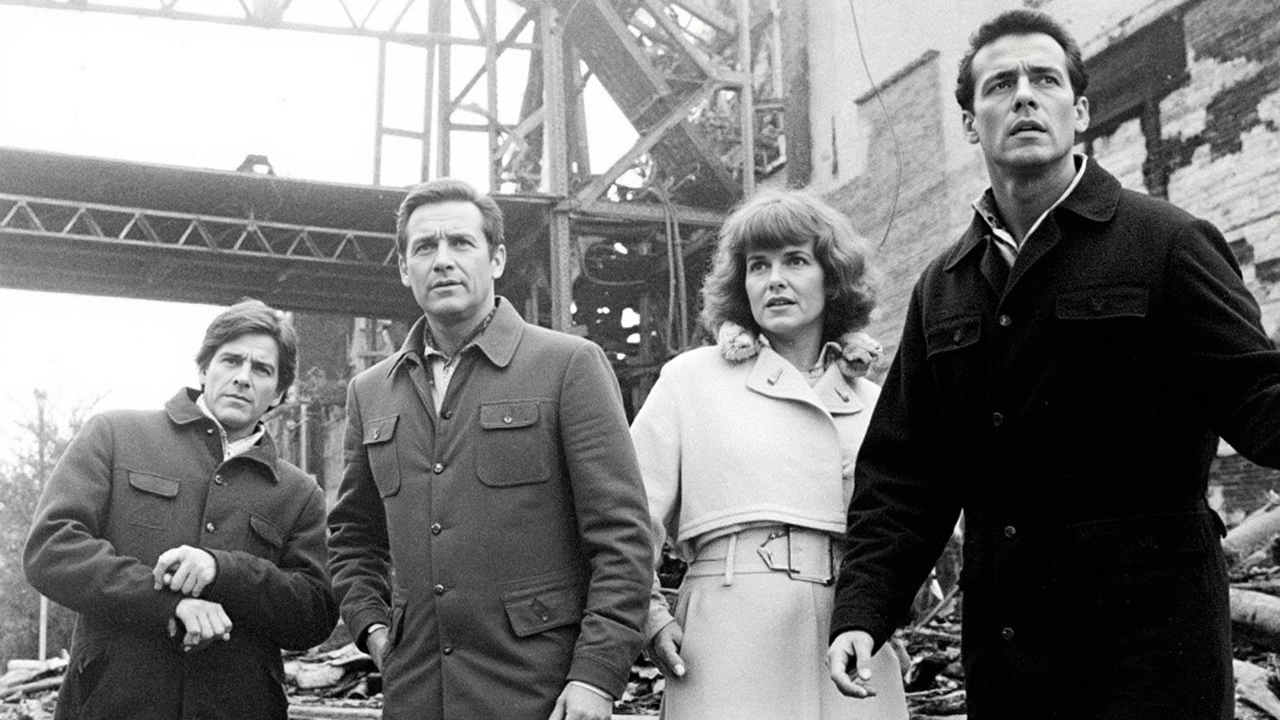The Impossible Shift: How Tom Cruise Turned a TV Show into a Blockbuster Franchise
Back in 1996, Hollywood took a big risk by dusting off a popular 1960s spy show and betting that audiences would go for a flashy, big-budget reboot. That gamble paid off in a way few could have imagined. Director Brian De Palma handed the reins to Tom Cruise, then best known for dramas and thrillers, and watched him step into the role of Ethan Hunt—a role that would define Cruise for decades.
The first Mission: Impossible wasn’t just another action flick. It kickstarted a new kind of blockbuster, sparking life into a franchise that now stretches across nearly three decades. Cruise played Hunt, an IMF agent set up as the ultimate fall guy after a mission goes painfully wrong. That plot twist alone was enough to pull people in, but De Palma dialed adrenaline up to maximum with a vault sequence that’s still one of the most recognizable moments in movies. When Cruise is lowered by wires into a room bristling with sensors, every bead of sweat felt like life or death. There were no overblown digital effects—just real tension and practical stunts that made audiences hold their breath.

Star Power, Stunts, and a Smidge of Backlash
Cruise’s willingness to hang from helicopters, dangle off trains, and eventually cling to the outside of airplanes changed expectations for action heroes. Instead of guns and gadgets doing all the work, the actor himself became the spectacle. The first film’s $457 million box office haul proved that audiences wanted more than just nostalgia—they wanted speed, risk, and stars risking it all.
But not everyone cheered. Fans and some cast members from the original TV show couldn’t stomach the overhaul. Greg Morris, a standout from the series, called the film “an abomination” and walked out early—a pretty clear sign the film’s darker, more ruthless tone wasn’t for everyone. Some missed the ensemble feel of the old show, which the movie swapped for a laser focus on Cruise’s Ethan Hunt. For TV purists, this was less homage, more hijack.
The criticism, though, was drowned out by the film’s success.
- Globetrotting set pieces became the new normal for spy movies.
- Practical stunts—done by stars, not doubles—became the franchise’s signature.
- The model of building a series around a single charismatic figure caught on fast, shifting the way franchises are built in Hollywood.
Seven sequels later—with “Dead Reckoning Part One” out in 2023 and Part Two on deck for 2025—Mission: Impossible is synonymous with high-octane adventure. Even as other franchises fade or reboot, this series proves a mix of inventive stunts, ruthless pacing, and star-power can still blow up the box office.

darryl archer
May 25, 2025 AT 19:12While the original Mission: Impossible may appear as a simple action flick, it fundamentally altered the way studios approach franchise building. The film demonstrated that practical stunts could rival CGI in creating tension. Its box office success forced Hollywood to re-evaleate risk in favour of spectacle. The legacy continues to echo in modern blockbusters.
Dina DiCicco
May 25, 2025 AT 21:26Honestly, the reboot was a masterclass in modern cinema – it set the bar for all future spy movies 😂🚀. Anyone who doubts that is simply missing the point.
Kasey DellaPenna
May 25, 2025 AT 23:39The stunt work is insane they push the limits every single time and it feels raw and real you can tell Tom actually does the stuff he’s shown doing
Nelleke Elston
May 26, 2025 AT 01:52Sure, the movies are flashy but they’ve stripped away the clever ensemble storytelling of the original series, turning it into a vanity project for a single star.
Liz Lessner
May 26, 2025 AT 04:06I totally agree with the point about practical stunts – they add a real sense of danger that CGI just cant replicate, even if the budget was huge.
Chance Remien
May 26, 2025 AT 06:19When one examines the 1996 Mission: Impossible through a cultural lens, one perceives more than a mere action spectacle; it becomes a symptom of a shifting Hollywood paradigm. The decision to resurrect a 1960s television property signaled the industry's willingness to mine nostalgia while simultaneously reinventing narrative structures. By centering the story around a solitary protagonist, the film prefigured the star‑driven franchises that dominate contemporary cinema. Moreover, the reliance on practical effects reinforced a philosophy that authenticity can engender audience immersion more effectively than digital illusion. The iconic vault sequence, performed without computer‑generated augmentation, exemplifies this commitment to tangible risk. Such moments invite viewers to confront mortality vicariously, forging an emotional bond that transcends the screen. In addition, the film's global setting anticipated the now‑standard practice of intercultural set pieces, expanding the visual vocabulary of espionage storytelling. The commercial triumph, quantified at $457 million, provided empirical evidence that audiences reward daring physicality over narrative complexity. This result altered studio calculus, prompting a cascade of high‑octane blockbusters that prioritize spectacle. Critics who lament the loss of ensemble dynamics may overlook the nuanced choreography of individual heroism that the film presents. Philosophically, the narrative interrogates themes of trust, betrayal, and the malleability of identity within clandestine institutions. The protagonist's forced scapegoating mirrors broader societal anxieties about institutional accountability. By embedding these concerns within a kinetic framework, the film achieves a rare synthesis of entertainment and commentary. Consequently, the legacy of Mission: Impossible endures not merely as a commercial franchise but as a cultural artifact reflecting late‑20th‑century cinematic values. Future scholars will likely cite its influence when tracing the evolution of modern blockbuster aesthetics. Ultimately, the film invites us to reconsider the relationship between risk, heroism, and audience expectation.
Anna Lee
May 26, 2025 AT 08:32Wow, what a ride! The way Tom Cruise dives into those insane stunts, it’s like he’s saying “bring it on” every single time, and honestly, it keeps the audience on the edge of their seats, craving more! Even the smaller set pieces, like the hallway chase, feel fresh and exhilarating, dont you think?
Daniel Craine
May 26, 2025 AT 10:46Honestly, the movie tries way too hard; it’s all flash, no depth, and the plot feels like a stretched‑out excuse to showcase endless explosions, which, frankly, is exhausting, especially when the characters are hollow shells, merely props for the next daring stunt.
Kristen VanPamel
May 26, 2025 AT 12:59The film’s influence is undeniable it set the template for modern action cinema.
Reid Vance
May 26, 2025 AT 15:12Exactly! Every blockbuster now copies the solo hero formula, from the opening chase to the climactic set‑piece, all because of that 1996 catalyst.
Javier cox
May 26, 2025 AT 17:26I love how the series brings different cultures into the mix – from Moscow to Dubai it showcases global diversity while still delivering the excitement we all crave.
Giacinta Pace
May 26, 2025 AT 19:39Great post! It really shows how a single movie can change an entire industry.
Gayleen Lowrie
May 26, 2025 AT 21:52Do you think this trend will continue as technology evolves, or will audiences eventually crave deeper storytelling over spectacle?
Wesley Nakamatsu
May 27, 2025 AT 00:06From an American cinematic perspective, the film exemplifies our nation’s capacity to innovate and dominate the global entertainment market, reaffirming our cultural leadership.
Tyler Tucker
May 27, 2025 AT 02:19This franchise is just overhyped.
julia mutambara
May 27, 2025 AT 04:32Reading through this history reminds us how perseverance and vision can reshape an entire genre. The dedication of the cast and crew to perform real stunts inspires countless aspiring filmmakers. Each sequel builds upon the last, weaving new layers of complexity while retaining the core thrill. Audiences worldwide have grown to expect nothing less than breath‑taking action, and the franchise delivers without fail. It also serves as a testament to the power of collaboration across borders, uniting talent from diverse backgrounds. The narrative arcs, though sometimes formulaic, provide enough emotional stakes to keep viewers invested. Even critics who dismiss the movies for their spectacle cannot deny the cultural impact they have achieved. Ultimately, the Mission: Impossible saga stands as a beacon of cinematic ambition, encouraging future storytellers to push boundaries.
vicky fachrudin
May 27, 2025 AT 06:46Indeed, the phenomenon you describe illustrates a broader ontological shift in popular media; wherein the pursuit of visceral experience supersedes traditional narrative structures, thereby redefining audience engagement, and prompting scholars to reassess the criteria by which cinematic value is measured.